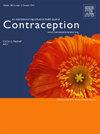OBSTETRIC-RELATED EMTALA VIOLATIONS POST-DOBBS: A DIFFERENCE-IN-DIFFERENCES ANALYSIS
IF 2.3
2区 医学
Q1 OBSTETRICS & GYNECOLOGY
引用次数: 0
Abstract
Objectives
EMTALA mandates that hospitals receiving Medicare funding provide stabilizing treatment, which includes abortion. But many states have abortion bans that lack, or only broadly articulate, exceptions related to a pregnant person’s health, leading to significant legal debate. We therefore sought to evaluate the impact of Dobbs v Jackson Women’s Health Organization on obstetric-related violations.
Methods
We used a nationwide sample of federal EMTALA violations (excluding Rhode Island, Delaware, and Hawaii) from 2017 to the end of 2023. We ran a two-way fixed effects difference-in-differences model comparing “conflict” states, ie, those whose state policy had no health exception in the post-Dobbs period (n=6) to non-conflict states. We examined obstetric-related violations as a share of all EMTALA filings as the primary dependent variable and used the 2022 Dobbs ruling as our intervention, employing state and month fixed-effects to account for unobservable differences by location and seasonality in healthcare utilization. We tested alternate treatment groups and examined changes in emergency department utilization as sensitivity analyses.
Results
Difference-in-differences results suggested that Dobbs led to a statistically significant increase in obstetric-related EMTALA violation filings, with 10.5% (95% CI, 8.1-12.9%; p <0.001) more violations filed per month in states with no health exception (Oklahoma, Idaho, South Dakota, Arkansas, Texas, and Mississippi) than in states with a health exception in the post-policy period, from 2022 through 2023.
Conclusions
Our analysis of Freedom of Information Act-acquired data indicates that the Dobbs ruling led to an increase in obstetric-related EMTALA violations when state law conflicted with federal policy.
产后产科相关emtala违规:差异中的差异分析
目的emtala要求接受医疗保险资助的医院提供稳定治疗,其中包括堕胎。但是,许多州的堕胎禁令缺乏与孕妇健康有关的例外情况,或者只是笼统地阐明,这导致了重大的法律辩论。因此,我们试图评估多布斯诉杰克逊妇女健康组织案对与产科有关的侵权行为的影响。方法:我们使用了2017年至2023年底全国范围内的联邦EMTALA违规样本(不包括罗德岛州、特拉华州和夏威夷)。我们运行了一个双向固定效应差异模型,比较“冲突”国家,即那些国家政策在后多布斯时期(n=6)没有健康例外的国家与非冲突国家。我们将产科相关违规作为所有EMTALA文件的份额作为主要因变量,并使用2022年Dobbs裁决作为我们的干预措施,采用州和月固定效应来解释医疗保健利用中不可观察到的地点和季节性差异。我们测试了替代治疗组,并检查了急诊科使用率的变化作为敏感性分析。结果差异中的差异结果表明,Dobbs导致与产科相关的EMTALA违规申请在统计上显著增加,在没有健康例外的州(俄克拉何马州、爱达荷州、南达科他州、阿肯色州、德克萨斯州和密西西比州),每月的违规申请比在政策后时期(2022年至2023年)有健康例外的州多10.5% (95% CI, 8.1-12.9%; p <0.001)。结论对《信息自由法》获得的数据的分析表明,当州法律与联邦政策相冲突时,多布斯裁决导致了与产科相关的EMTALA违规行为的增加。
本文章由计算机程序翻译,如有差异,请以英文原文为准。
求助全文
约1分钟内获得全文
求助全文
来源期刊

Contraception
医学-妇产科学
CiteScore
4.70
自引率
17.20%
发文量
211
审稿时长
69 days
期刊介绍:
Contraception has an open access mirror journal Contraception: X, sharing the same aims and scope, editorial team, submission system and rigorous peer review.
The journal Contraception wishes to advance reproductive health through the rapid publication of the best and most interesting new scholarship regarding contraception and related fields such as abortion. The journal welcomes manuscripts from investigators working in the laboratory, clinical and social sciences, as well as public health and health professions education.
 求助内容:
求助内容: 应助结果提醒方式:
应助结果提醒方式:


